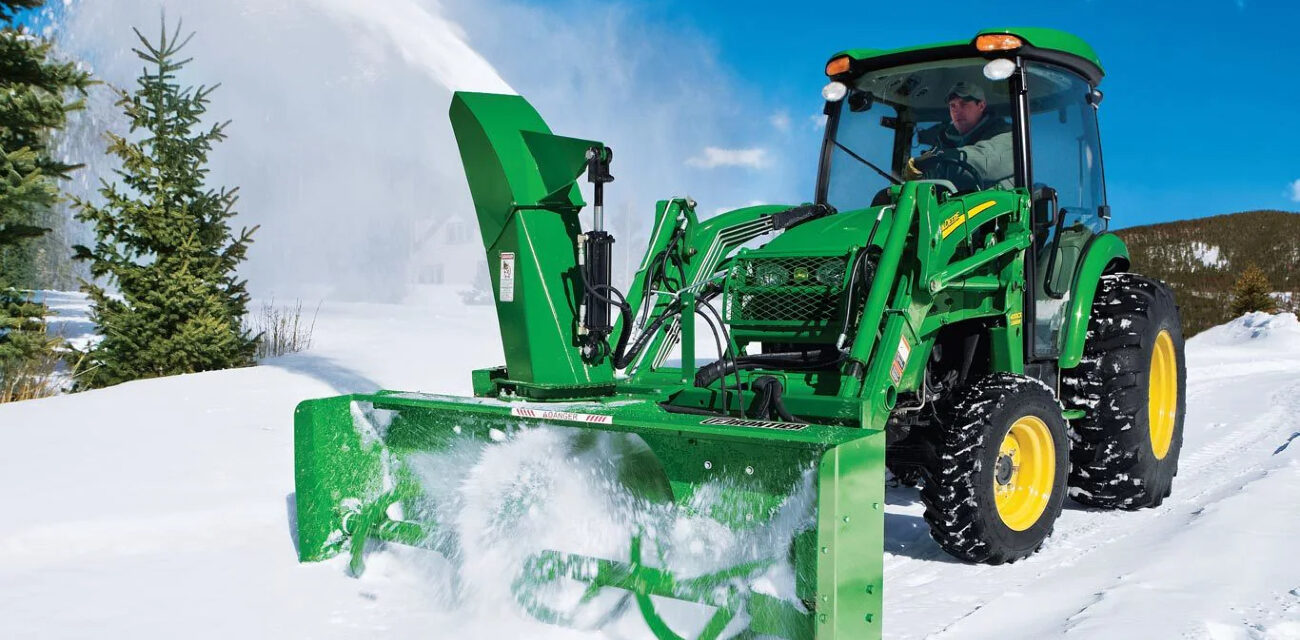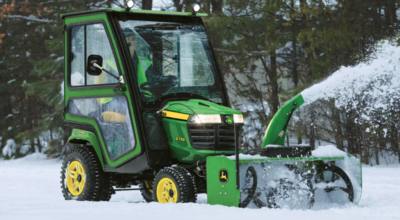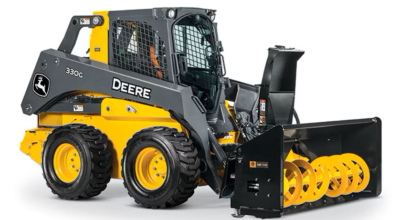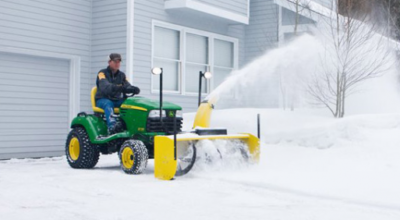Winter snows may be picturesque, but they can also bring the daunting task of clearing driveways and walkways. While manual snow shoveling is an option, it’s labor-intensive, time-consuming, and can be physically demanding. Fortunately, your John Deere snow blowers can be an invaluable ally in this battle. However, to make the most of your snow blower and ensure your safety, it’s essential to follow some key tips.
In this article, we’ll share the ten best snow blower tips to help you clear snow like a pro. From choosing the right snow blower to maintenance and safety advice, we’ve got you covered.
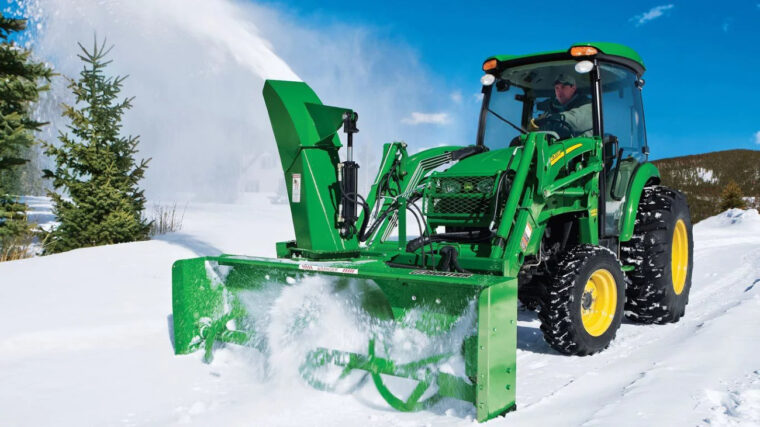
What is a Snow Blower?
A snow blower, also known as a snow thrower, is a machine designed for the efficient removal of snow from driveways, walkways, and other surfaces. It functions by collecting snow and expelling it through a chute, allowing you to clear your path quickly and with minimal physical effort. John Deere offers an assortment of snow blower attachments that you can detach and reattach to your tractor or other John Deere vehicle as needed.
Why Use a Snow Blower for Snow Removal?
Using a snow blower for snow removal offers several advantages over traditional shoveling, making it a smart investment for both residential and commercial snow-clearing needs. Here are a few of those advantages:
- Efficiency: Snow blowers can clear large areas in less time than shoveling.
- Reduced Physical Strain: Snow blowers require less physical exertion, reducing the risk of strain or injury.
- Consistency: Snow blowers provide consistent results, leaving a clean, clear surface with each pass.
- Suitable for Heavy Snowfall: Snow blowers are effective in removing deep or heavy snow, which can be challenging to handle manually.
In other words, snow blowers are not only time-savers but also a safer and more reliable option for snow removal, especially in regions prone to heavy snowfall. They offer a convenient and efficient solution to ensure your paths, driveways, and walkways remain clear and accessible during the winter months.
10 Tips to Maximize the Use of Your Snow Blower
Now, let’s explore the ten tips to maximize the use of your snow blower, making your snow-clearing process efficient and safe:
1. Use Fresh Fuel
One of the most critical aspects of snow blower maintenance is ensuring you use fresh fuel. Always refuel your snow blower when it’s completely cooled down. Adding fuel while the engine is still hot can damage the machine and pose a fire hazard. If you run out of fuel during the task, wait for the engine to cool down before refilling.
2. Start the Engine in a Safe Space
Avoid starting your snow blower in enclosed areas like sheds or crowded garages, as its engine expels harmful fumes. Opt for a well-ventilated space or, whenever possible, start the machine outside.
3. Look Out for Any Trash That May Damage Your Snow Blower
Before you start clearing snow, scan the area for any objects that could damage your snow blower, such as rocks, dog tie-out cables, extension cords, and garden hoses. Additionally, check for half-buried newspapers, which are a common cause of machine jams. Removing obstacles ensures a smoother snow-clearing process.
4. Check the Direction of the Wind
Take a moment to assess which way the wind is blowing, as it can significantly affect your clearing strategy. By understanding the wind’s direction, you can work with it rather than against it, optimizing your snow-clearing efficiency. For example, adjust the chute angle to clear snow in the same direction as the wind. This adjustment will give you better results than trying to go against the wind.
5. Throw Snow As Far As Possible
One of the keys to efficient snow removal is maximizing the distance the snow is thrown so it’s less likely to accumulate in areas you’ve already cleared. This prevents the need for repeated passes, speeding up the snow removal process. To get the most out of your snow blower’s capabilities, be sure to run the machine at full speed and angle the chute outward so snow is thrown away from your vehicle rather than up in the air.
6. Take in Smaller Snow Bites to Avoid Clogging
A common mistake is trying to clear too much snow in a single pass. This can lead to clogs in the snow blower’s chute. Instead of attempting to clear a wide swath of snow, take smaller bites, roughly one-third to one-half the width of your machine. By doing so, you’ll reduce the likelihood of clogs, and your snow blower will throw snow farther.
7. Work Steadily
While it might be tempting to speed through the task, a steady pace is more effective. Going too fast can clog the chute, increase wear and tear on the machine, and reduce the equipment’s lifespan. A steady and manageable pace is key to efficient snow removal. The goal is to clear the snow with minimal disruption and optimal results.
8. Avoid Tampering
It’s crucial to never leave your snow blower running and unattended, even for a brief moment. Unattended equipment poses safety risks, especially if children or pets are present. Always turn off the machine before stepping away from it, even if just for a moment.
9. Always Be Attentive
During snow blower operation, stay focused on the task at hand. Keep both hands on the machine’s controls for better control. Operator errors, such as abrupt changes in direction or engaging the machine improperly, can lead to clogs and breakdowns. Maintaining your attention on the task ensures smooth operation.
10. Understand Your Machine’s Capabilities
Every snow blower has its limits. Familiarize yourself with your specific machine’s capabilities, including its throwing distance and power. Don’t push it beyond what it’s designed to handle. Knowing and respecting your snow blower’s capabilities not only ensures safe operation but also prolongs the life of the machine.
Commonly Asked Questions about Snow Blower Tips
Are Snow Blowers Easy to Use?
Snow blowers are generally user-friendly, but understanding proper techniques is crucial for efficient and safe operation. The tips provided in this guide are designed to help you get the most out of your snow blower.
How Deep Should the Snow Be to Use a Snow Blower?
For optimal results, it’s advisable to start clearing snow when its depth is less than six inches. Removing smaller amounts of snow enables your snow blower to work more effectively, improving both its performance and longevity.
How Can I Make My Snow Blower Throw Snow Better?
To maximize the throwing distance of your snow blower, follow the tips mentioned in this guide, such as adjusting the chute’s angle, running the machine at full speed, and clearing snow in the same direction as the wind. These techniques will help you get the most out of your snow blower’s capabilities.
How Long Should I Let My Snow Blower Run?
In general, the duration for which you should run your snow blower varies depending on the snow conditions and the machine’s power source. For example, especially wet or heavy snow may require more frequent breaks for your snow blower to prevent overexertion. Additionally, your snow blower will have different recommended runtimes depending on whether it’s battery or gasoline-powered. Always follow the manufacturer’s guidelines to ensure safe usage.

Clear Snow Like a Pro with John Deere Snow Blower
By following these ten best snow blower tips, you can make your snow removal tasks safer and more manageable. Whether you’re a seasoned pro or new to snow blowing, these insights will help you maintain your snow removal equipment, maximize its efficiency, and ensure your safety during winter’s chill. For even more efficient snow clearing, consider using a snow blower from John Deere, a renowned name in outdoor equipment. To find your nearest dealer, check out the John Deere locator.
If you enjoyed this post or want to read others, feel free to connect with us on Facebook, Pinterest, Twitter, or Instagram!
